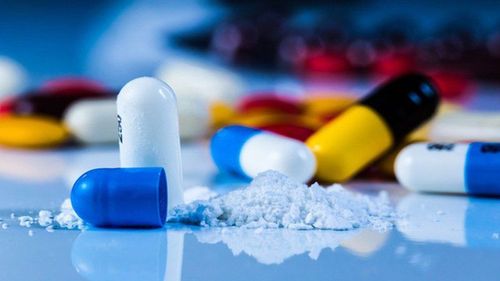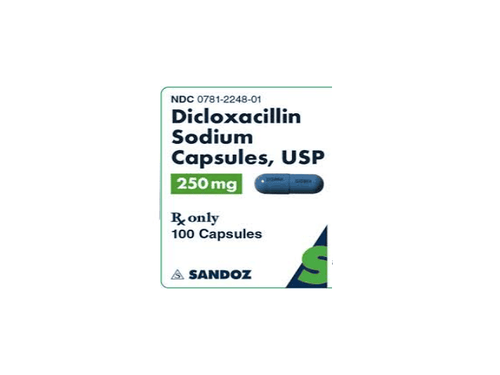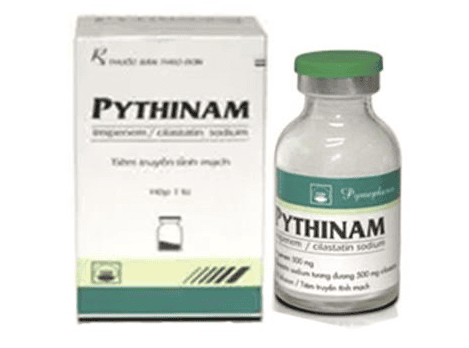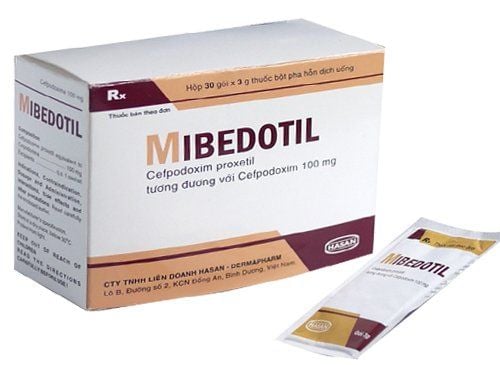This is an automatically translated article.
Opxil 250mg contains the main ingredient Cephalexin, an anti-parasitic, anti-infective, antifungal and viral drug. It is used to treat infections of the ear, nose and throat, respiratory tract, urinary tract, skin, and soft tissue.
1. What does opxil 250 do?
Cephalexin ingredient in Opxil 250 mg is a semi-synthetic Cephalosporin antibiotic, effective in the treatment of infections caused by susceptible bacteria such as:
Bone and joint infections; Skin and soft tissue infections; otitis media ; Respiratory tract infections; Genitourinary tract infections, including acute prostatitis; Dental infections; Strep throat ; Pneumonia , skin infections; The drug can be used in the prevention of infective endocarditis.
2. Dosage and usage
How to use:
Cephalexin is a powdered medicine used to mix with water, so that the drug can be best absorbed into the body, the patient should take it on an empty stomach, preferably 1 hour before eating. Dosage for adults:
The dose is applied from 1-4g/day, depending on the disease status, the degree of infection. Most common bacterial infections will use a dose of 500mg corresponding to 2 sachets, used 8 hours apart. For some diseases with mild symptoms such as skin and soft tissue infections, urinary tract infections, strep throat, the applied dose is 250mg/time, 6 hours apart or 500mg every 12 hours. hours. For patients with severe infections, the doctor will prescribe a higher dose. Note: In cases where a daily dose of more than 4g is required, the patient will be recommended to use injectable Cephalosporin.
Dosage for the elderly:
Use the same dose as above, but if the patient has problems related to kidney function, the dose should be considered. Dosage for children:
For children over 5 years old, the general application dose is usually 25-50 mg/kg/day divided into several oral doses. If the child has a common bacterial infection, use a dosage of 250mg. Children with otitis media are indicated to use the dose from 75-100mg / kg / day, divided into 4 times a day. If the child has a skin infection, strep throat, mild urinary tract infection, the dose can be divided into 1 day, used 12 hours apart. In case of severe infections in children, the dose can be doubled. If the child is infected with beta-hemolytic cocci, the duration of treatment is at least 10 days. For patients with renal failure:
If the creatinine clearance is higher than 40ml/min, the patient does not need to reduce the dose. If creatinine clearance is less than 40ml/min the first dose can be used in the normal range, however, subsequent doses need to be adjusted according to creatinine clearance, specifically as follows: Clearance between 10-40ml / min using a dose of 500mg (about 2 packs), 8 to 12 hours apart. Clearance is 5-10ml/min using a dose of 250mg (about 1 sachet), every 12 hours. Clearance is less than 5 ml/min using a dosage of 250 mg (approximately 1 sachet), every 12 to 24 hours. For patients on hemodialysis:
Use 1 dose after each hemodialysis session, in case of continuous abdominal dialysis at home, use the same dosage as in patients with renal failure. Treatment of missed dose:
When you forget a dose, the patient should take it as soon as he remembers, if it is almost time for the next dose, the patient should skip the missed dose and take the next dose exactly as prescribed. prescribed by your doctor, do not arbitrarily exceed the dose to make up for the missed dose.
3. Overdosage and treatment
When patients use too much, they will experience some reactions such as vomiting, nausea, epigastric pain, diarrhea and blood in urine.
How to handle:
In case of serious reactions when using an overdose, the patient needs to be closely monitored for problems related to kidney and liver function and do necessary hematology tests. , to ensure that the body's indicators are stable. In the case of high levels of overdose, such as 5 to 10 times the total daily dose, gastric lavage may be necessary. Currently, there have been cases of drug overdose in children (more than 3.5g/day) and blood in urine, in which case immediate supportive treatment is required.
4. Do not use drugs for cases
The user is allergic to any ingredient of Opxil 250. Hypersensitivity to Cephalexin and allergy to Cephalosporin antibiotics. The patient has a history of anaphylaxis due to penicillin.
5. Be careful when taking medicine
If the patient is allergic to Cephalexin, it is necessary to stop using the drug and replace with other more suitable drugs. In the case of patients using Cephalexin for a long time, it is necessary to monitor their body condition carefully, because susceptible microorganisms may overgrow leading to unwanted side effects. In patients with impaired renal function, use Oxil 250 with caution. The drug may affect the results of the Coombs test if the patient takes Opxil 250 prior to the test. Therefore, it is necessary to inform the doctor if the patient is preparing to undergo blood-related tests. Affects urine glucose test results with Benedict or Fehling's solution, produces a false-positive reaction. Using the drug for pregnant women: Although there are currently no clinical studies to prove that the drug can cause teratogenicity. However, the drug should still be used with caution in this case. For women who are breast-feeding: Caution should be exercised when Oxil 250 is used in nursing women because studies have demonstrated that Cephalexin can be excreted in breast milk. After a dose of about 500mg, Cephalexin will set a peak concentration of 4 micrograms / ml, after 8 hours, the drug concentration will gradually decrease. Therefore, before using the drug in women who are breast-feeding, it is necessary to consult a doctor.
6. Drug interactions
Opxil 250 may interact in the following cases:
Other beta-lactam antibiotics such as Probenecid. Some studies prove that when using Cephalexin in combination with Metformin, there will be some reactions of the body. However, this interaction did not cause any serious side effects. When using Cephalexin in combination with Gentamicin causes hypokalemia in patients with leukemia. Cephalexin reduces the effectiveness of the estrogen component in birth control pills. Cephalexin reduces the body's absorption of the drug Cholestyramine. Concomitant use with Probenecid will cause a reaction that increases the serum concentration and elimination time of Cephalexin from the body, affecting the rate of renal excretion. Cephalexin reduces the effectiveness of typhoid vaccine.
7. Unwanted side effects of drugs
Common reactions:
Diarrhea, nausea, vomiting. Uncommon reactions:
Blood: Increased eosinophils. Skin: Itching, urticaria, rash. Liver: Increased transaminases present in the liver. Central nervous system: Dizziness, fatigue, hallucinations, headache, anxiety, confusion. Rare reactions:
Gastrointestinal: Gastrointestinal disturbances, pseudomembranous colitis, abdominal pain. Blood: Decreased platelets and neutrophils. Skin: Hepatitis, increased AST, ALT, jaundice. Body as a whole: dizziness, dizziness, anaphylactic reactions. Urology, genitourinary: Genital pruritus, reversible interstitial nephritis, vaginitis. The article has provided information about the uses, dosage and precautions when using Oxil 250. To ensure the safety of your health and maximize the effectiveness of treatment, you need to take the medicine exactly as directed by your doctor.
Please dial HOTLINE for more information or register for an appointment HERE. Download MyVinmec app to make appointments faster and to manage your bookings easily.













